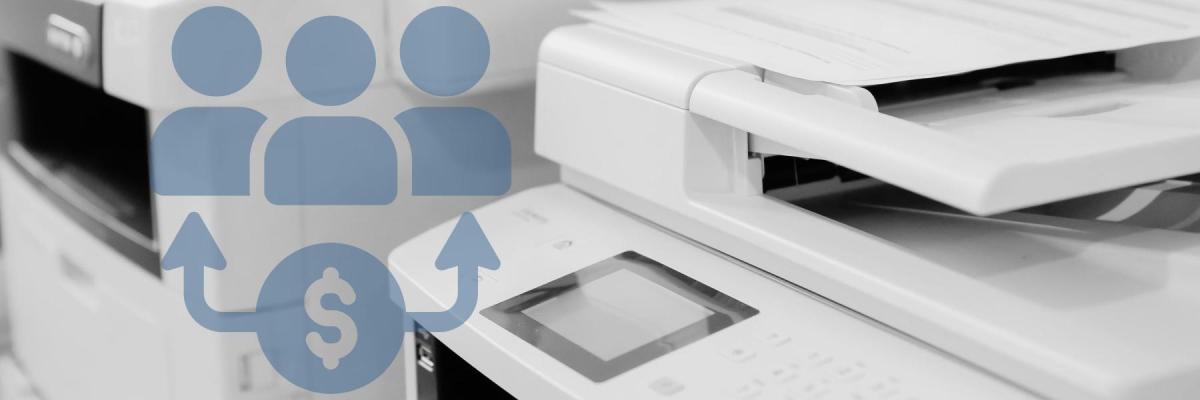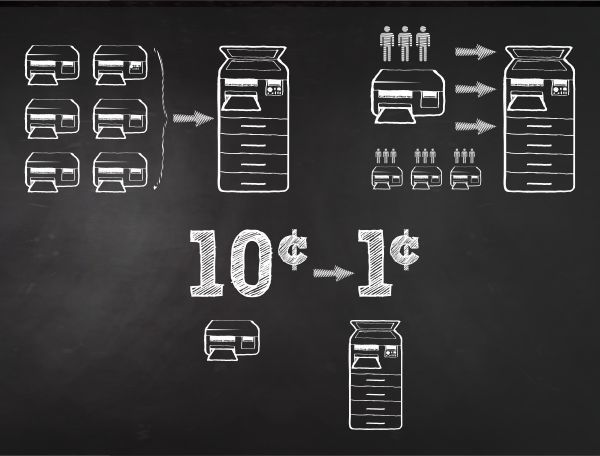
Printer pooling is when multiple printers are linked to share the number of print impressions included in your service contract.
Pooling printers can be beneficial if your company uses many printers because it allows you to consolidate the number of prints included for a billing period into one amount.
If you own a Xerox printer, then pooling is a valuable option offered that can help prevent overage charges. As a Xerox Platinum Solutions Partner, our goal at STPT is to help you take advantage of billing options like pooling.
Pooling makes printing easier so that users don’t have to worry about where they can print important documents, and it can significantly decrease the amount of billing paperwork for your company.
But is printer pooling right for your business?
In this article, we’ll explain the specifics of printer pooling, including the pros, cons, and associated costs.
After reading, you will know what pooling is and whether you should inquire about printer pooling for your upcoming purchase.
Understanding Print Impressions
You may have noticed the term print impressions in the previous section. The terminology can be a bit confusing, so let’s break it down.
If you want to assess whether printer pooling is right for your company, then you’ll also need to know what impressions are and how they dictate the number of documents you can print.
A print impression is a single printed image reproduced from a printing surface onto a piece of paper.
When you set up your contract for printing services, you can either pay per impression, or you can establish a plan that includes a set number of impressions per period.
This number is typically stipulated in your print contract for the machine.
Usually, print contracts are concrete, and you can only add monthly impressions to your total included during the contract term.
It can be difficult, if not impossible, to reduce the number of prints originally included in your contract, which means you could overestimate your printing needs and choose an excessive number of impressions.
It is important to allow for the right number of impressions in your initial contract, regardless of whether you will be using a printer pool. Overestimating can lead to extra expense.
Read our blog 8 Questions Answered About Impressions Included in a Print Contract for more information on print impressions and how they fit into contracts.
What Is Printer Pooling?
How Does Printer Pooling Work? At STPT, we offer printer pooling, which enables companies to “pool” or consolidate all their contracted impressions into one number. This means that, if you have multiple machines, they can share the number of monthly print impressions between them.
Instead of paying more money to cover extra prints from a machine with lower output capacity, STPT will merge the number of allotted impressions across all your printers in the pool, which allows each machine on contract to use the sum of all included impressions. This saves you money by limiting overage costs for high output printers that would otherwise exceed their monthly allowance of print impressions.
So, what is the advantage of printer pooling?
3 Pros to Printer Pooling for Businesses
If you are a large company with at least 5 or more printers in daily use, then printer pooling may be right for you for a few key reasons:
Pooling Printers Saves You Money
Extra costs are often incurred by going over the print impression allotment set up in the printing contract for your machine.
By pooling multiple printers, you can spread out a set amount of print volume over several machines. This cuts down on print overage costs for your company.
Billing is Less Complicated When You Pool
Printer pooling reduces billing headaches for businesses. When the number of print impressions per period is consolidated, you receive a single bill.
The bill is easy to read and understand, significantly reducing paperwork for you and your company.
Pooling Can Reduce User Stress
When your printers are pooled as a fleet with a combined number of impressions, you don’t have to worry as much about exceeding the number of allowed impressions for one machine.
Instead of worrying about whether a printer has enough prints left for you to accomplish your work goals for the week or month, you can share prints among multiple machines.
2 Cons to Printer Pooling
Printer Pools Are Not for Everyone
Typically, a printer pool requires a company to have several machines in daily use. If your business utilizes a small number, you may not be approved for a printing pool and the benefits of pooling may not be worth it for you.
Although anyone can set up a pool for printing, it may not be financially advantageous for your business if you consistently use less than five printers or prefer to use printer models with smaller outputs. It is best to base your decision on your company’s individual printing needs. For the best results, let your printing services vendor guide you through the process.
If you’re interested in setting up a pool of printers, STPT offers flexible agreements and will work with your company—even if you use less than five printers. Contact us for more information.
Some People May Require a Separate Bill for Each Machine
Some companies may require separate bills for each printer due to individual billing concerns. If your business involves multiple departments working within their own streams of revenue, then pooling all prints into one number may not work for you.
How Much Does it Cost?
If you can pool all your included impressions for each printer, then you will have one set number of print impressions that covers your billing period.
This is a good option for you if your company or office requires many machines to meet printing demands.
The cost of printer pooling varies depending on your printer fleet and the terms of your print contract, so figuring a price that is specific to your company can be complicated.
Typically, black-and-white print impressions cost around $0.0079 - $0.03 per page and color prints are around $0.05 - $0.30 per page.
But if your printers are pooled in a fleet, then the cost of each device is averaged to create a common price per page. The graphic (below) is an example of how printer pooling works, courtesy of Tui Space:
The price per page for printing varies depending on the model of printer you are using, so when you pool different printer models together, the rate is blended to create one common overage rate that is unique to you and your printing devices.
Depending on what company you use, there could be a monthly fee, or an overage rate adjustment (which is usually about 10%) based on the overage click rate.
If you would like us to run the numbers and help you figure out the cost of printer pooling specific to your business, then request a quote today.
How Can You Cut Printing Costs and Save Money?
This is why we at STPT are dedicated to helping you understand what printer pooling is and how it can save your company money.
Wasting print impressions has financial consequences and could lead to your company overspending on print services needlessly every month.
If you want to learn more about machine pooling and other valuable printing services available to Xerox customers local to the DFW area, check out this handy breakdown of STPT’s Managed Print Services.
If you are interested in contracting a machine for use in a printer pool, read our comprehensive guide (linked below) for expert tips on how to purchase or lease a printer for your business:

